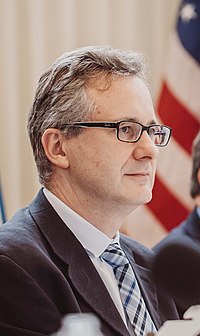
Biophysics is an interdisciplinary science that applies approaches and methods traditionally used in physics to study biological phenomena. Biophysics covers all scales of biological organization, from molecular to organismic and populations. Biophysical research shares significant overlap with biochemistry, molecular biology, physical chemistry, physiology, nanotechnology, bioengineering, computational biology, biomechanics, developmental biology and systems biology.

Nanoid robotics, or for short, nanorobotics or nanobotics, is an emerging technology field creating machines or robots whose components are at or near the scale of a nanometer. More specifically, nanorobotics refers to the nanotechnology engineering discipline of designing and building nanorobots with devices ranging in size from 0.1 to 10 micrometres and constructed of nanoscale or molecular components. The terms nanobot, nanoid, nanite, nanomachine and nanomite have also been used to describe such devices currently under research and development.

Cadherins (named for "calcium-dependent adhesion") are cell adhesion molecules important in forming adherens junctions that let cells adhere to each other. Cadherins are a class of type-1 transmembrane proteins, and they depend on calcium (Ca2+) ions to function, hence their name. Cell-cell adhesion is mediated by extracellular cadherin domains, whereas the intracellular cytoplasmic tail associates with numerous adaptors and signaling proteins, collectively referred to as the cadherin adhesome.

Molecular biophysics is a rapidly evolving interdisciplinary area of research that combines concepts in physics, chemistry, engineering, mathematics and biology. It seeks to understand biomolecular systems and explain biological function in terms of molecular structure, structural organization, and dynamic behaviour at various levels of complexity. This discipline covers topics such as the measurement of molecular forces, molecular associations, allosteric interactions, Brownian motion, and cable theory. Additional areas of study can be found on Outline of Biophysics. The discipline has required development of specialized equipment and procedures capable of imaging and manipulating minute living structures, as well as novel experimental approaches.
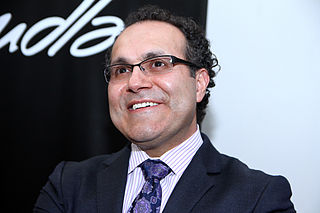
Alfredo Quiñones-Hinojosa is a Mexican-American neurosurgeon, author, and researcher. Currently, he is the William J. and Charles H. Mayo Professor and Chair of Neurologic Surgery and runs a basic science research lab at the Mayo Clinic Jacksonville in Florida.

Single-particle tracking (SPT) is the observation of the motion of individual particles within a medium. The coordinates time series, which can be either in two dimensions (x, y) or in three dimensions (x, y, z), is referred to as a trajectory. The trajectory is typically analyzed using statistical methods to extract information about the underlying dynamics of the particle. These dynamics can reveal information about the type of transport being observed (e.g., thermal or active), the medium where the particle is moving, and interactions with other particles. In the case of random motion, trajectory analysis can be used to measure the diffusion coefficient.
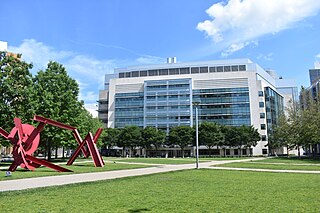
The Koch Institute for Integrative Cancer Research at MIT is a cancer research center affiliated with the Massachusetts Institute of Technology (MIT) located in Cambridge, Massachusetts, United States. The institute is one of seven National Cancer Institute-designated basic laboratory cancer centers in the United States.
Stanley Corrsin was an American physicist, fluid dynamicist, and Theophilus Halley Smoot Professor of Engineering at the Johns Hopkins University. He was known for his contributions in the field of fluid dynamics in general and turbulence in particular. He was a recipient of Fluid Dynamics Prize in 1983. Corrsin died of cancer on 2 June 1986 at the age of 66.
The following outline is provided as an overview of and topical guide to biophysics:
Taekjip Ha is a South Korean-born American biophysicist who is currently a Bloomberg Distinguished Professor of Biophysics and Biomedical Engineering at Johns Hopkins University. He was previously the Gutgsell Professor of Physics, at University of Illinois at Urbana-Champaign where he was the principal investigator of Single Molecule Nanometry group. He is also a Howard Hughes Medical Institute investigator.
The Physical Sciences in Oncology Network (PS-ON) is a network of centers and projects set up by the National Institutes of Health (NIH) National Cancer Institute (NCI) to link the physical sciences with the study of cancer. The program was launched in 2009 with Physical Sciences in Oncology Centers (PS-OCs) investigating complex and challenging questions in cancer research from a physical sciences perspective. To explore how the NCI could continue to support the integration of physical sciences and cancer research, a Think Tank and series of Strategic Workshops were held in 2012. These meetings served to update opportunities at the interface of physical sciences and cancer research and guided the development of the second phase including Physical Sciences in Oncology Projects (PS-OPs).
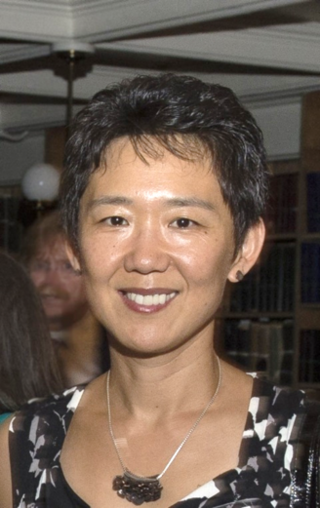
Rong Li is the Director of Mechanobiology Institute, a Singapore Research Center of Excellence, at the National University of Singapore. She is a Distinguished Professor at the National University of Singapore's Department of Biological Sciences and Bloomberg Distinguished Professor of Cell Biology and Chemical & Biomolecular Engineering at the Johns Hopkins School of Medicine and Whiting School of Engineering. She previously served as Director of Center for Cell Dynamics in the Johns Hopkins School of Medicine’s Institute for Basic Biomedical Sciences. She is a leader in understanding cellular asymmetry, division and evolution, and specifically, in how eukaryotic cells establish their distinct morphology and organization in order to carry out their specialized functions.
Mauro Ferrari is a nanoscientist and leader in the field of nanomedicine. He served as special expert on nanotechnology for the National Cancer Institute (2003-2005) and was instrumental in establishing the Alliance for Nanotechnology in Cancer in 2004. On 1 January 2020, Ferrari was made president of the European Research Council (ERC). Following a vote of no confidence, on 27 March 2020, "all 19 active members of the ERC’s Scientific Council individually and unanimously requested that Mauro Ferrari resign from his position as ERC’s President", due to poor conduct in office, exploiting the position to further his own projects, and for consistently failing to represent the interests of the ERC. On 7 April 2020, Ferrari officially resigned, stating to the media that he was "extremely disappointed by the European response” to the pandemic and expressing frustration over opposition to his efforts to launch a scientific program to combat the virus.
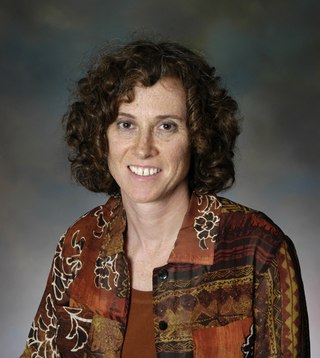
Clare M. Waterman is a cell biologist who has worked on understanding the role of the cytoskeleton in cell migration. Waterman is a Distinguished Investigator, Chief of the Laboratory of Cell and Tissue Morphodynamics, and Director of the Cell and Developmental Biology Center at the National Heart, Lung, and Blood Institute (NHLBI), in the National Institutes of Health (NIH) in Bethesda MD, USA. Waterman has received several awards and honors, including the Sackler International prize in Biophysics, the NIH Director’s Pioneer Award, and the Arthur S. Flemming Award for Public Service. In 2018, she was elected to the National Academy of Sciences. She currently serves on the editorial boards of eLife, Current Biology and Journal of Microscopy.
Ravi Salgia is an Indian-American oncologist who is the Arthur & Rosalie Kaplan Chair and Professor in Medical Oncology at the Comprehensive Cancer Center of City of Hope. Salgia serves on multiple National Cancer Institute panels. He has received research grants from the NIH for his work and has been granted several invention discoveries and patents concerning his research and became the Fellow of the Royal Society of Medicine. He has written 800 articles, reviews, and editorials with peer review, two books, and 34 book chapters.

Christopher S. Chen, born in 1968, is an American biological engineer. He is the William Fairfield Warren Distinguished Professor of Biomedical Engineering at Boston University and member of the Wyss Institute for Biologically Inspired Engineering at Harvard University in Boston.
Yan Xiyun is a Chinese nanobiologist, academician of the Chinese Academy of Sciences, researcher and doctoral supervisor of the Institute of Biophysics, and professor of the University of the Chinese Academy of Sciences. Her main accomplishment was the discovery of nanozymes and its application in tumor diagnosis.
Kalina A. Hristova is a Bulgarian–American engineer. She is a professor of materials science and engineering at Johns Hopkins University's Whiting School of Engineering.
Andrew Ewald is a professor of cell biology at Johns Hopkins University School of Medicine. He is known for his contributions in the field of metastatic breast cancer research.

Andre Francis Palmer is an American engineer who is the Associate Dean for research in the College of Engineering and the Fenburr Ohio Eminent Scholar and Professor of Chemical and Biomolecular Engineering at Ohio State University. He is an expert on hemoglobin-based oxygen carriers and biomaterials used in transfusion medicine.
